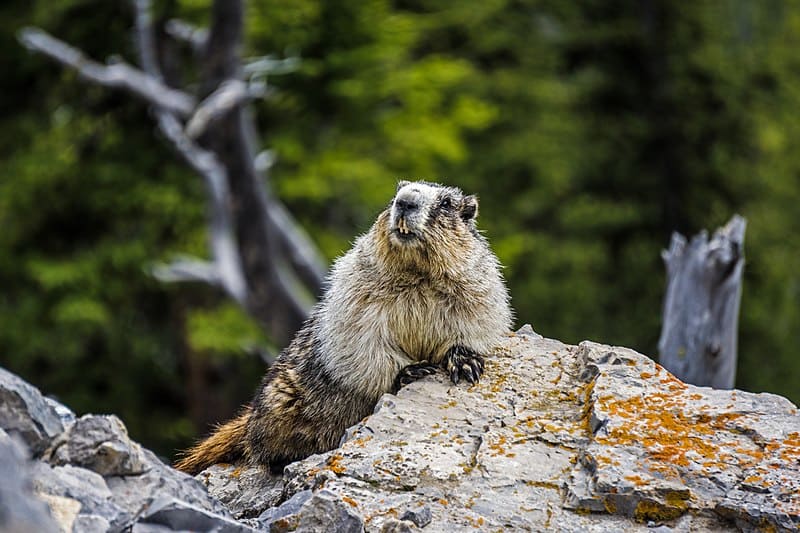
Hoary Marmot Facts
- The most notable thing about the remarkable Hoary Marmot might surprise many of you. That’s because this animal actually represents a variety of ground squirrel. This incredible creature further ranks as the largest in its range, surprising one again.
- This amazing mammal additionally remains a surprisingly intelligent creature. This statement remains evidenced by its demonstrated patterns of behavior. That’s due to the fact that while the colony feeds, a few individuals watch for predators.
- As a result of this behavioral pattern, if a threat appears, the ever vigilant sentry quickly emits a high-pitched warning cry. Due to the nature of this outcry, in some parts of its range the Hoary Marmot has been given the name of whistle pig.
- Quite thankfully, its numbers appear to be both sufficient and stable, at least for the moment. For this reason, the IUCN currently ranks the beautiful creature as Least Concern. That could potentially change, however, due to the actions of man.
- Sadly, numerous factors related to human civilization now threaten the species. Habitat loss certainly ranks as one of these, of course, due to human expansion. Its greatest threat, however, must be considered to be the ongoing effects of climate change.
Related Articles
Hoary Marmot Physical Description
Quite amazingly, that the impressive Hoary Marmot represents a large type of ground squirrel determines much. It has a bulky build, with a broad head, and also short, but powerful limbs. It also, however, displays a marked degree of sexual dimorphism.
In its specific case, though, this manifests itself in the fact that the males grow much larger than females. That applies to both it and its subspecies. Mature males average a body length of 22 in (55.9 cm). These same individuals also have a tail of about 9.8 in (25 cm).
The females, meanwhile, only average roughly 17.3 in (43.9 cm) in body length. These further possess a tail of 6.7 in (17 cm). The same females also tend to be somewhat less stocky in build. Weights for both genders vary significantly, depending on the season.
The term hoary remains a reference to the fur on the upper back and shoulders of the fabulous Hoary Marmot. That’s because this part of its fur displays a silvery-gray color. This remains in stark contrast to the tan or reddish-brown color the rest of the body shows.
- Kingdom: Animalia
- Phylum: Chordata
- Class: Mammalia
- Order: Rodentia
- Family: Sciuridae
- Genus: Marmota
- Species: M. caligata
Hoary Marmot Distribution, Habitat, and Ecology
Perhaps most notably, the fabulous Hoary Marmot only inhabits a comparatively limited portion of northwest North America. This region includes parts of Idaho, Washington, and Alaska, in the United States, and also British Columbia in Canada.
Even more precisely, the intrepid rodent also displays highly specific preferences regarding its choice of habitats. These primarily consist of mountainous alpine ecosystems. It also thrives best at altitudes ranging from sea level up to as much as 8,200 ft (2,500 m).
Within that range, however, individuals frequently live in either areas of grasslands and sedge, or rocky regions. It also inhabits several small islands near Alaska, however. There, the animal tends to live near the shoreline, having proven itself to be adaptable.
The Hoary Marmot further appears to be entirely herbivorous in terms of its dietary nature. Although exact diets vary, this fascinating large rodent mainly consumes grasses, sedge, leaves, and flowers. It also evolved as diurnal in nature, like many mammals.
Remarkably, the animal additionally has a highly prolonged hibernation period. In point of fact, it commonly spends 7-8 months of the year in this state. This period it spends in large, deep burrows, commonly shared by a colony of as many as 36 individuals.
Species Sharing Its Range
North American Beaver
Check out our other articles on 6 Extremely Localized Invertebrates, Eurasian Red Squirrel, Ascension Island Parsley Fern, Hot Water Beach, Atlantic Trumpetfish, Hawksbill Sea Turtle
